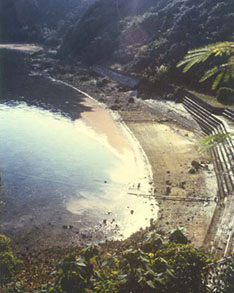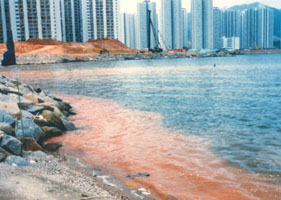Dynamics of Algal Blooms and Red Tides in Coastal Waters:
Monitoring, Modelling and Prediction
Team members:
Prof. JHW Lee, Prof. PJ Harrison,
Prof. IJ Hodgkiss, Prof. MD Dickman, Dr. AW. Jayawardena, Dr. A Koenig,
Dr. XY Li,
Prof. RSS Wu, Dr. PPS Wong, Dr. HS Lee, Dr. WT Lee, Dr. Y Huang, Dr. KTM Wong,
GTMK Fernado
ˇ@
Introduction
ˇ@
In sub-tropical coastal waters around Hong Kong, algal blooms (the rapid growth of microscopic phytoplankton) are often observed. Under the right environmental conditions there blooms can occur and subside over rather short time scales, in the order of days to a few weeks. Algal blooms often lead to discoloration of the marine water (e.g. red tides), which may led to beach closures, severe dissolved oxygen depletion, fish kills, and shellfish poisoning Over the past two decades, massive fish kills due to oxygen depletion have been observed in some of the marine fish culture zones in Hong Kong; toxic algal blooms have, however, been relatively rare. Nevertheless, in April 1998, a devastating red tide has resulted in the worst fish kill in Hong Kongˇ¦s history ˇV it wiped out over 80% (3,400 tones) of fish stocks, with estimated loss of more than HK312 million.
ˇ@
|
A red tide observed in Kat O |
A red tide observed in Hong Kong coastal water |
ˇ@
ˇ@
Whereas the general ecological response of phytoplankton to environmental condition has been extensively studied, the causality and dynamics of algal blooms are not well-understood. This is the first systematic inter-disciplinary group research to tackle the red tide problem in Hong Kong. The objectives of the project are:
-
To advance the understanding of algal bloom dynamics in sub-tropical waters through an integrated field monitoring and mathematical modeling study.
-
To study novel ways of modeling algal dynamics by integrating biology, environmental hydraulics, water quality modeling, and optimization techniques .
-
To develop an online early warning system for forecasting algal blooms nd red tides; develop strategies for minimizing red tied occurrences and improving mariculture management and disaster mitigation.
ˇ@
ˇ@

